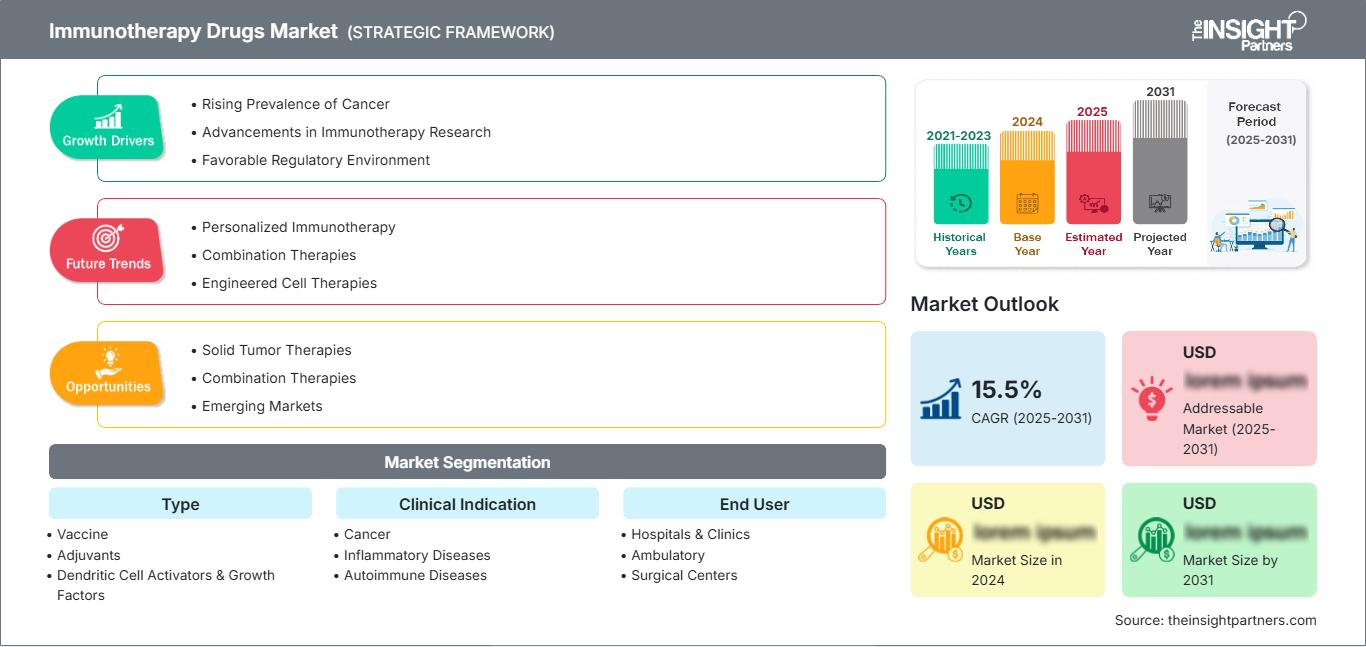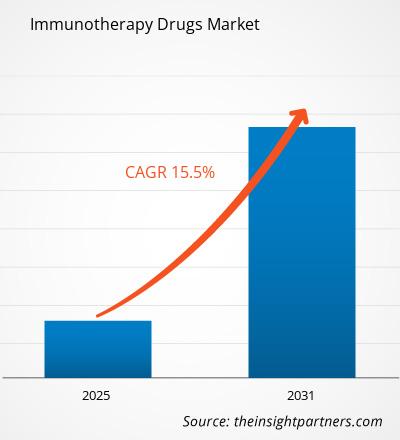Le marché des médicaments d'immunothérapie devrait atteindre 391,81 milliards de dollars américains d'ici 2031. Il devrait enregistrer un TCAC de 10,2 % entre 2025 et 2031.
Le rapport est segmenté par type (vaccins, adjuvants, activateurs et facteurs de croissance des cellules dendritiques, stimulateurs et facteurs de croissance des lymphocytes T, inhibiteurs de points de contrôle immunitaire, anticorps monoclonaux, interleukines et interférons, autres) et par indication clinique (cancer, maladies inflammatoires, maladies auto-immunes, maladies infectieuses, autres). L'analyse mondiale est ensuite ventilée par région et par principaux pays.
Objectif du rapport
Le rapport sur le marché des médicaments d'immunothérapie, réalisé par The Insight Partners, vise à décrire le paysage actuel et la croissance future, les principaux facteurs de croissance, les défis et les opportunités. Cela permettra d'éclairer divers acteurs économiques, tels que :
- Fournisseurs de technologies/Fabricants : Pour comprendre l'évolution de la dynamique du marché et identifier les opportunités de croissance potentielles, afin de prendre des décisions stratégiques éclairées.
- Investisseurs : Pour réaliser une analyse approfondie des tendances concernant le taux de croissance du marché, les projections financières et les opportunités tout au long de la chaîne de valeur.
- Organismes de réglementation : Pour encadrer les politiques et les activités du marché afin de minimiser les abus, préserver la confiance des investisseurs et garantir l'intégrité et la stabilité du marché.
Segmentation du marché des médicaments d'immunothérapie
- Vaccins
- Adjuvants
- Activateurs et facteurs de croissance des cellules dendritiques
- Stimulants et facteurs de croissance des lymphocytes T
- Inhibiteurs de points de contrôle immunitaire
- Anticorps monoclonaux
- Interleukines et interférons
- Autres
Indication clinique
- Cancer
- Maladies inflammatoires
- Maladies auto-immunes
- Maladies infectieuses
- Autres
Utilisateur final
- Hôpitaux et cliniques
- Soins ambulatoires
- Centres chirurgicaux
- Autres
Répartition géographique
- Amérique du Nord
- Europe
- Asie-Pacifique
- Amérique du Sud et centrale
- Moyen-Orient et Afrique
Vous bénéficierez d’une personnalisation sur n’importe quel rapport - gratuitement - y compris des parties de ce rapport, ou une analyse au niveau du pays, un pack de données Excel, ainsi que de profiter d’offres exceptionnelles et de réductions pour les start-ups et les universités
Marché des médicaments d'immunothérapie: Perspectives stratégiques

-
Obtenez les principales tendances clés du marché de ce rapport.Cet échantillon GRATUIT comprendra une analyse de données, allant des tendances du marché aux estimations et prévisions.
Facteurs de croissance du marché des médicaments d'immunothérapie
- Prévalence croissante du cancer : L'incidence croissante de divers types de cancers, en particulier les cancers liés au système immunitaire, stimule la demande de médicaments d'immunothérapie.
- Progrès de la recherche en immunothérapie : La recherche et le développement continus en immunothérapie mènent à la découverte de nouvelles thérapies et combinaisons de traitements.
- Environnement réglementaire favorable : Des cadres réglementaires favorables et des procédures d'approbation accélérées accélèrent le développement et la commercialisation des médicaments d'immunothérapie.
Tendances futures du marché des médicaments d'immunothérapie
- Immunothérapie personnalisée : Adaptation des traitements d'immunothérapie aux besoins individuels des patients en fonction de leur profil génétique et des caractéristiques de leur tumeur.
- Thérapies combinées : Association de l'immunothérapie à d'autres traitements, tels que la chimiothérapie et la radiothérapie, afin d'améliorer l'efficacité et de réduire les effets secondaires.
- Thérapies cellulaires modifiées : Développement de thérapies cellulaires modifiées, telles que la thérapie CAR-T, pour cibler des cellules cancéreuses spécifiques.
Opportunités du marché des médicaments d’immunothérapie
- Thérapies des tumeurs solides : Élargissement du champ d’application de l’immunothérapie au traitement des tumeurs solides, telles que les cancers du poumon, du sein et du côlon.
- Thérapies combinées : Développement de thérapies combinées innovantes pour améliorer les résultats pour les patients et lutter contre la résistance aux traitements.
- Marchés émergents : Ciblage des marchés émergents présentant des besoins de santé croissants et une demande accrue de traitements anticancéreux de pointe.
Marché des médicaments d'immunothérapie
Les analystes de The Insight Partners ont analysé en détail les tendances régionales et les facteurs influençant le marché des médicaments d'immunothérapie tout au long de la période prévisionnelle. Cette section aborde également les segments et la répartition géographique du marché de la prise en charge des troubles du rythme cardiaque en Amérique du Nord, en Europe, en Asie-Pacifique, au Moyen-Orient et en Afrique, ainsi qu'en Amérique du Sud et centrale.
Portée du rapport sur le marché des médicaments d'immunothérapie
| Attribut de rapport | Détails |
|---|---|
| Taille du marché en 2024 | US$ XX Billion |
| Taille du marché par 2031 | US$ 391.81 Billion |
| TCAC mondial (2025 - 2031) | 10.2% |
| Données historiques | 2021-2023 |
| Période de prévision | 2025-2031 |
| Segments couverts |
By Type
|
| Régions et pays couverts |
Amérique du Nord
|
| Leaders du marché et profils d'entreprises clés |
|
Densité des acteurs du marché des médicaments d'immunothérapie : comprendre son impact sur la dynamique commerciale
Le marché des médicaments d'immunothérapie connaît une croissance rapide, portée par une demande croissante des utilisateurs finaux, elle-même alimentée par l'évolution des préférences des consommateurs, les progrès technologiques et une meilleure connaissance des avantages du produit. Face à cette demande grandissante, les entreprises élargissent leur offre, innovent pour répondre aux besoins des consommateurs et tirent parti des tendances émergentes, ce qui stimule davantage la croissance du marché.

- Obtenez le Marché des médicaments d'immunothérapie Aperçu des principaux acteurs clés
Points clés de vente
- Couverture exhaustive : Ce rapport analyse en détail les produits, services, types et utilisateurs finaux du marché des médicaments d’immunothérapie, offrant ainsi une vision globale.
- Analyse d’experts : Ce rapport repose sur une connaissance approfondie du secteur et des analystes.
- Informations actualisées : Grâce à sa couverture des informations et tendances les plus récentes, ce rapport garantit la pertinence de vos analyses.
- Options de personnalisation : Ce rapport peut être personnalisé pour répondre aux besoins spécifiques de chaque client et s’adapter parfaitement à ses stratégies commerciales.
Ce rapport d’étude de marché sur les médicaments d’immunothérapie peut donc vous aider à décrypter et comprendre le contexte sectoriel et les perspectives de croissance. Malgré quelques points à améliorer, les avantages de ce rapport l’emportent généralement sur les inconvénients.
- Analyse historique (2 ans), année de base, prévision (7 ans) avec TCAC
- Analyse PEST et SWOT
- Taille du marché Valeur / Volume - Mondial, Régional, Pays
- Industrie et paysage concurrentiel
- Ensemble de données Excel
Rapports récents
Rapports connexes
Témoignages
Raison d'acheter
- Prise de décision éclairée
- Compréhension de la dynamique du marché
- Analyse concurrentielle
- Connaissances clients
- Prévisions de marché
- Atténuation des risques
- Planification stratégique
- Justification des investissements
- Identification des marchés émergents
- Amélioration des stratégies marketing
- Amélioration de l'efficacité opérationnelle
- Alignement sur les tendances réglementaires






















 Obtenez un échantillon gratuit pour - Marché des médicaments d'immunothérapie
Obtenez un échantillon gratuit pour - Marché des médicaments d'immunothérapie